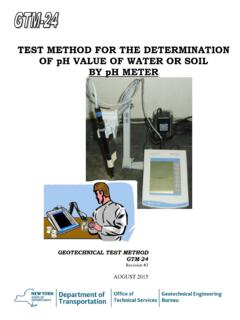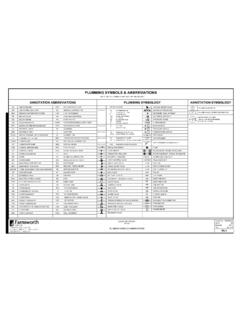Transcription of Acid Rain Experiments - Cornell University
1 Environmental Inquiry Cornell University , Ithaca, NY 14853 acid rain Experiments Background acid precipitation is defined to have a pH lower than In New York, the average pH of rainfall is and individual storms as low as are not unusual. Freshwater lakes commonly are slightly basic. pH's in the range of to are optimal for most organisms, and below is lethal to many fish species. The susceptibility of lakes to changes in pH varies depending on how well buffered they are. Measured as alkalinity, the buffering capacity of water is a function primarily of the concentration of carbonate (CO3=) and bicarbonate (HCO3 ) ions.
2 In areas with limestone (CaCO3) bedrock, surface waters have high concentrations of carbonate and bicarbonate and therefore are able to resist change in pH. The pH of a well-buffered lake does not change dramatically following a storm or snowmelt period because the acidity becomes neutralized by these ions. In regions where the bedrock is granite, the soils and surface waters are naturally low in alkalinity. One such region is the Adirondack Mountains, where approximately 20% of the lakes are too acidic to support fish life. One approach to restoring acidic lakes is to add lime to the lake itself, to the influent streams, or to the watershed land.
3 This can be simulated in the laboratory using baking soda (NaHCO3), horticultural lime, or a stomach antacid such as Tums, which is made up of CaCO3. Experimental Problem #1 (Standard Problem) What is a buffer? What happens to the pH of a buffered solution when acid or base is added, and how does this compare to an unbuffered solution? Suggested Steps Introduction Discussion of acid rain : What is acid rain ? What are the causes? What regions are most affected? What can we deduce from maps of geology and soils of New York State? Why are some lakes more susceptible to acid rain than are others?
4 acid rain Experiments Environmental Inquiry 2 Materials distilled water Buffered Solution: add 1/2 tsp baking soda to 1 liter distilled water acid rain Solution: add 4 ml 1M H2SO4 to 2 liters distilled water. ph meter , test kit, pH paper, or Universal Indicator Solution beakers or clear plastic cups (200-ml size, two per student or group 25-ml graduated cylinders (one per student or group of students) 10-ml pipette (one per student or group of students) safety goggles gloves optional: alkalinity test kit Procedure 1.)
5 Put 25 ml distilled water into one beaker and 25 ml Buffered Solution into another. 2. Add 6 drops Universal Indicator Solution to each beaker. {Note the color differences between the two solutions. The distilled water is slightly acidic because of dissolved carbon dioxide; the baking soda solution is slightly basic.} 3. Using a pipette, carefully add acid rain Solution drop by drop to the beaker containing distilled water, swirling after each addition until the color stabilizes. How much do you need to add to make the solution turn pink and stay that color, indicating that it is acidic?
6 4. Using a 25-ml graduated cylinder, carefully add acid rain Solution to the cup containing the buffered solution. Add a few ml at a time, swirling and observing the color changes. How much do you need to add to make the solution turn a stable pink? 5. Optional: Measure the alkalinity of distilled water and of Buffered Solution, then relate the alkalinity measurements to the amounts of acid needed to cause a pH change in the two solutions. Discussion Why were there differences in the amount of acid needed to change the pH of these two solutions? What is a buffer?
7 How does this relate to lakes in New York State? acid rain Experiments Environmental Inquiry 3 Experimental Problem #2 (Original Problem) Materials: Same as for experiment Problem #1, plus: assorted soil samples coffee filters rubber bands Procedure: Design an experiment or set of Experiments that use the materials provided to address one or more of these questions: 1. Does soil change the pH of water that drains through it? 2. Can soil reduce the acidity of water draining into a lake? 3. Do some types of soil buffer drainage water better than do other soil types?
8 4. Can the buffering capacity of soils be depleted? 5. Does the buffering capacity of a soil relate to the alkalinity of water that has drained through it? 6. What components of soil provide its buffering capacity? Suggested Outline for Lab Writeup I. Prediction Statement II. Lab Log What you did and when, problems that arose and how you addressed them. III. Interpretation A summary of your data, preferably in graphs. IV. Tips for Future Experimenters Recommendations for improving upon or extending the research, addressed to students taking this class next year. acid rain Experiments Environmental Inquiry 4 Assessment Items Traditional Items 1.
9 Which of these two lakes is more likely to experience large drops in pH due to acid precipitation? Why? Mirror Lake Loon Lake pH: temp.: 6oC 4oC alkalinity 50 ppm 200 ppm dissolved oxygen 13 ppm 7 ppm 2.
10 If you steadily add acid to a well-buffered solution, you would expect the pH to: (a) Increase immediately. (b) Initially remain constant, then begin dropping. (c) Decrease gradually but steadily. (d) Stay constant for a while, then begin rising. 3. Universal Indicator Solution is used to indicate the pH of liquids: it turns red in acidic solutions, green in neutral solutions, and purple in basic solutions. When Universal Indicator Solution is added to a sample of water from Mystery Lake, the water turns green. Adding some weak acid turns the solution red, but after mixing it returns to green.


